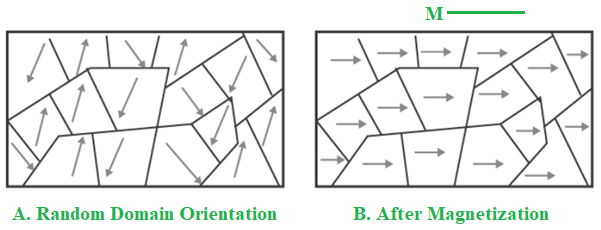铁磁性——定义、原因、性质、滞后
有几种类型的磁性,其中铁磁性是最强大的。铁磁材料在原子水平上具有自发的净磁化强度,即使不存在外部磁场也是如此。当铁磁材料暴露于外部磁场时,它们会在磁场方向上高度磁化。磁铁会强烈地吸引铁磁材料。即使撤去外部磁场,这些材料也会在一段时间内保持磁化。滞后是此特性的名称。
什么是铁磁性?
Ferromagnetism takes its name from the term “ferrous,” which refers to iron, which was the first metal discovered to have magnetic field-attractive characteristics.
铁磁性是某些材料(例如铁、钴、合金等)所具有的磁性。这是某些材料产生持久磁性或吸引特性的现象。它也被称为不带电元素积极相互吸引的过程。铁磁性是一种特性,不仅考虑材料的化学组成,还考虑其微观结构和晶体结构。
铁磁性的原因
在未磁化的铁磁材料中称为域的微小区域中的原子偶极子朝向相同的方向。即使在没有外部磁场的情况下,畴也具有净磁矩。另一方面,相邻域的磁矩方向相反。它们相互抵消,导致材料的净磁矩为零。当施加外部磁场时,所有这些畴都沿施加场的方向排列。由于该过程,材料在平行于磁化场的方向上被强烈磁化。

铁磁材料
Ferromagnetic materials are a class of materials that, when exposed to a magnetic field, tend to express or display significant magnetism in the direction of the field. The alignment patterns of these materials’ component atoms are primarily responsible for their magnetic. These atoms have a tendency to act like basic electromagnets.
铁磁材料的例子
金属构成了铁磁材料的大部分。铁、钴、镍和其他铁磁材料是常见的例子。此外,铁磁材料包括金属合金和稀土磁体。铁氧化成氧化物产生磁铁矿,一种铁磁性物质。它的居里温度为 580°C。它以前被称为磁性物质。磁铁矿是地球上所有天然矿物中最具磁性的。
铁磁材料的性质
- 在域中,铁磁物质的原子具有持久的偶极矩。
- 在铁磁材料中,原子偶极子的取向与外部磁场的方向相同。
- 磁偶极矩很大并且朝向磁化场的方向。
- 磁化强度 (M) 非常高且为正,并且随磁化场 (H) 线性变化。因此,饱和度由材料的成分决定。
- 磁化率相当高且为正。磁化率定义为X m = M ⁄ H ,其中 M 是磁化强度,H 是施加的磁场强度。
- 该材料的磁通密度将非常高且为正。在铁磁材料内部,磁场线变得非常粗。 B = ε 0 (H + M)磁通密度,其中ε 0为自由空间的磁介电常数,H为外加磁场强度,M为磁化强度。
- 相对磁导率同样非常高并且随磁场线性变化。材料内部的磁场明显大于材料外部的磁场。它们倾向于从材料中拉入大量的力线。
- 该场强烈地吸引铁磁材料。他们更喜欢坚持在非均匀场中场强的两极。
- 如果将铁磁粉末放置在设置在两个足够分开的磁极片上的表玻璃中,粉末会聚集在侧面并在中心显示凹陷,因为磁极在磁极处最强。
- 由于较高的温度,铁磁材料在液化时会失去其铁磁特性。
滞后
当去除外部磁场时,铁磁性物质不会完全退磁。必须提供相反方向的磁场以使材料恢复为零磁化。磁滞是铁磁材料的一个特性,当外磁场被移除时,它们可以保持磁化强度。
When the magnetization of the material is measured in terms of magnetic flux density (B) and the external magnetic field strength (H), a loop is formed. This is known as hysteresis loop.

磁滞回线
当磁化力减小到零时,保持力是保持的磁通密度。必须提供以使材料完全退磁的反向磁场强度称为矫顽力。
居里温度
温度影响铁磁特性。当加热到足够高的温度时,铁磁性物质变成顺磁性的。居里温度是发生这种转变的温度。 T c是它的缩写。
铁磁材料的用途
铁磁材料在工业上有广泛的用途。电动机、电话、发电机、扬声器、变压器和信用卡背面的磁条都是使用它们的设备的例子。
示例问题
问题1:什么是铁磁性?
解决方案:
Ferromagnetism is a physical phenomenon (long-range ordering) in which certain materials, such as iron, are attracted to one another strongly. Rare earth minerals including gadolinium contain ferromagnets. Magnetism in magnets is caused by one of the most prevalent phenomena observed in everyday life.
问题 2:铁磁畴的形状像一个边长为 1 μm 的立方体。求域中的铁原子数。 (铁的分子质量 = 55g mol -1和密度 = 7.92 g ⁄ cm 3 )
解决方案:
Given:
Side length, l = 1 μm
The volume of the cubic domain, V = (1 μm)3
= (1 × 10−6 m)3
= 1 × 10−12 cm3
Mass, M = V × d
= 1 × 10−12 cm3 × 7.92 g ⁄ cm3
= 7.92 × 10−12 g
Now the Avagadro number (6.023 × 1023) of iron atoms have a mass of 55 g, so the number of atoms in the domain:
N = 7.92 × 10−12 g × 6.023 × 1023 ÷ 55
= 0.867 × 1011
Hence, the number of atoms in the domain is 0.867 × 1011 atoms.
问题 3:如果将铁磁材料置于外部磁场中,会对磁畴产生什么影响?
解决方案:
For a ferromagnetic material, the magnetic domains align themselves in the direction of the external magnetic field. Domains are essentially directed tiny regions of atoms. When the domains aligned with the field are retained in an external magnetic field, the domains aligned with the field grow and take over regions formerly inhabited by domains oriented against the field. Hence, the domains increases in size.
问题4:什么是居里温度?
解决方案:
The Curie temperature, also known as the Curie point, is the temperature at which some materials lose their permanent magnetic characteristics, allowing induced magnetism to take their place.
问题5:铁磁性有什么应用?
解决方案:
A ferromagnetic material has a wide range of applications. The relevance of the hysteresis curve cannot be overstated. In transformers, electromagnets, and magnetic tape recording, ferromagnetism is used.